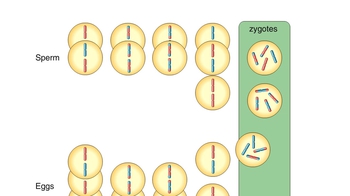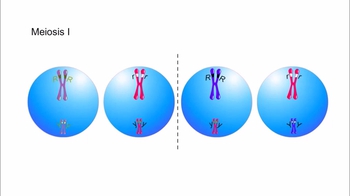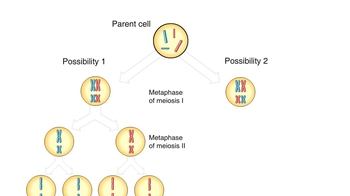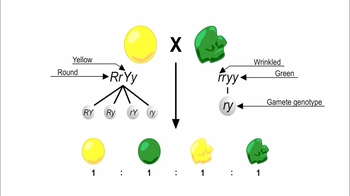Table of contents
- 1. Introduction to Biology2h 42m
- 2. Chemistry3h 40m
- 3. Water1h 26m
- 4. Biomolecules2h 23m
- 5. Cell Components2h 26m
- 6. The Membrane2h 31m
- 7. Energy and Metabolism2h 0m
- 8. Respiration2h 40m
- 9. Photosynthesis2h 49m
- 10. Cell Signaling59m
- 11. Cell Division2h 47m
- 12. Meiosis2h 0m
- 13. Mendelian Genetics4h 44m
- Introduction to Mendel's Experiments7m
- Genotype vs. Phenotype17m
- Punnett Squares13m
- Mendel's Experiments26m
- Mendel's Laws18m
- Monohybrid Crosses19m
- Test Crosses14m
- Dihybrid Crosses20m
- Punnett Square Probability26m
- Incomplete Dominance vs. Codominance20m
- Epistasis7m
- Non-Mendelian Genetics12m
- Pedigrees6m
- Autosomal Inheritance21m
- Sex-Linked Inheritance43m
- X-Inactivation9m
- 14. DNA Synthesis2h 27m
- 15. Gene Expression3h 20m
- 16. Regulation of Expression3h 31m
- Introduction to Regulation of Gene Expression13m
- Prokaryotic Gene Regulation via Operons27m
- The Lac Operon21m
- Glucose's Impact on Lac Operon25m
- The Trp Operon20m
- Review of the Lac Operon & Trp Operon11m
- Introduction to Eukaryotic Gene Regulation9m
- Eukaryotic Chromatin Modifications16m
- Eukaryotic Transcriptional Control22m
- Eukaryotic Post-Transcriptional Regulation28m
- Eukaryotic Post-Translational Regulation13m
- 17. Viruses37m
- 18. Biotechnology2h 58m
- 19. Genomics17m
- 20. Development1h 5m
- 21. Evolution3h 1m
- 22. Evolution of Populations3h 52m
- 23. Speciation1h 37m
- 24. History of Life on Earth2h 6m
- 25. Phylogeny2h 31m
- 26. Prokaryotes4h 59m
- 27. Protists1h 12m
- 28. Plants1h 22m
- 29. Fungi36m
- 30. Overview of Animals34m
- 31. Invertebrates1h 2m
- 32. Vertebrates50m
- 33. Plant Anatomy1h 3m
- 34. Vascular Plant Transport1h 2m
- 35. Soil37m
- 36. Plant Reproduction47m
- 37. Plant Sensation and Response1h 9m
- 38. Animal Form and Function1h 19m
- 39. Digestive System1h 10m
- 40. Circulatory System1h 57m
- 41. Immune System1h 12m
- 42. Osmoregulation and Excretion50m
- 43. Endocrine System1h 4m
- 44. Animal Reproduction1h 2m
- 45. Nervous System1h 55m
- 46. Sensory Systems46m
- 47. Muscle Systems23m
- 48. Ecology3h 11m
- Introduction to Ecology20m
- Biogeography14m
- Earth's Climate Patterns50m
- Introduction to Terrestrial Biomes10m
- Terrestrial Biomes: Near Equator13m
- Terrestrial Biomes: Temperate Regions10m
- Terrestrial Biomes: Northern Regions15m
- Introduction to Aquatic Biomes27m
- Freshwater Aquatic Biomes14m
- Marine Aquatic Biomes13m
- 49. Animal Behavior28m
- 50. Population Ecology3h 41m
- Introduction to Population Ecology28m
- Population Sampling Methods23m
- Life History12m
- Population Demography17m
- Factors Limiting Population Growth14m
- Introduction to Population Growth Models22m
- Linear Population Growth6m
- Exponential Population Growth29m
- Logistic Population Growth32m
- r/K Selection10m
- The Human Population22m
- 51. Community Ecology2h 46m
- Introduction to Community Ecology2m
- Introduction to Community Interactions9m
- Community Interactions: Competition (-/-)38m
- Community Interactions: Exploitation (+/-)23m
- Community Interactions: Mutualism (+/+) & Commensalism (+/0)9m
- Community Structure35m
- Community Dynamics26m
- Geographic Impact on Communities21m
- 52. Ecosystems2h 36m
- 53. Conservation Biology24m
12. Meiosis
Genetic Variation During Meiosis
Problem 9`
Textbook Question
You design Drosophila crosses to provide recombination data for gene a, which is located on the chromosome shown in Figure 15.12. Gene a has recombination frequencies of 14% with the vestigial wing locus and 26% with the brown eye locus. Approximately where is a located along the chromosome?
<IMAGE>
 Verified step by step guidance
Verified step by step guidance1
Understand that recombination frequency is a measure of genetic linkage and is used to estimate the distance between genes on a chromosome. It is expressed as a percentage, where 1% recombination frequency is equivalent to 1 map unit (centimorgan).
Identify the recombination frequencies given in the problem: 14% with the vestigial wing locus and 26% with the brown eye locus. These frequencies suggest the relative distances between gene a and the other two loci on the chromosome.
Visualize the chromosome as a linear map where each locus is positioned based on recombination frequencies. The vestigial wing locus and the brown eye locus are reference points, and gene a is somewhere between them.
Calculate the approximate position of gene a by considering the recombination frequencies as distances. If gene a is 14 map units from the vestigial wing locus and 26 map units from the brown eye locus, it suggests that gene a is closer to the vestigial wing locus than to the brown eye locus.
Place gene a on the chromosome map by estimating its position relative to the other loci. Since gene a is 14 map units from the vestigial wing locus and 26 map units from the brown eye locus, it is likely located between these two loci, closer to the vestigial wing locus.
 Verified video answer for a similar problem:
Verified video answer for a similar problem:This video solution was recommended by our tutors as helpful for the problem above
Video duration:
1mPlay a video:
Was this helpful?
Key Concepts
Here are the essential concepts you must grasp in order to answer the question correctly.
Genetic Recombination
Genetic recombination refers to the process by which two DNA molecules exchange genetic material, resulting in new combinations of alleles. In Drosophila, recombination occurs during meiosis, and the frequency of recombination between two loci can indicate their relative positions on a chromosome. Higher recombination frequencies suggest greater physical distances between genes.
Recommended video:

Sexual Reproduction and Recombination
Linkage Maps
Linkage maps are diagrams that show the relative positions of genes on a chromosome based on recombination frequencies. These maps are constructed by analyzing the recombination data from genetic crosses, allowing researchers to estimate the distance between genes. In this context, the recombination frequencies between gene a and other loci help determine its approximate location on the chromosome.
Recommended video:
Guided course

Map of the Lesson on Biomolecules
Chromosomal Mapping
Chromosomal mapping involves determining the physical location of genes on a chromosome. By using recombination frequencies, scientists can infer the order and distance between genes. In the given question, the recombination frequencies of gene a with the vestigial wing and brown eye loci provide clues to its position, suggesting it is closer to the vestigial wing locus than the brown eye locus.
Recommended video:
Guided course
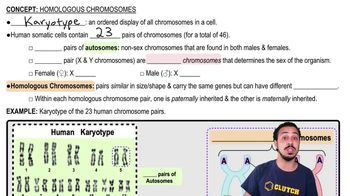
Homologous Chromosomes

 7:08m
7:08mWatch next
Master Genetic Variation During Meiosis with a bite sized video explanation from Jason
Start learningRelated Videos
Related Practice






